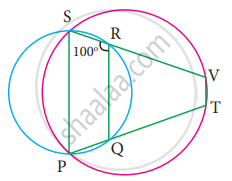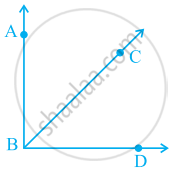Advertisements
Advertisements
Question
Two adjacent angles of a parallelogram are 70° and 110° respectively. Find the other two angles of it.
Solution
Given two adjacent angles of a parallelogram are 70° and 110° respectively.

Since, we know that opposite angles of a parallelogram are equal
∴∠C = ∠A = 70° and ∠D = ∠B = 110°
APPEARS IN
RELATED QUESTIONS
In a quadrilateral, define of the following Opposite angles .
In a quadrilateral, define of the following Exterior .
Complete of the following, so as to make a true statement:
The number of pairs of adjacent angles of a quadrilateral is .......
Complete of the following, so as to make a true statement:
The sum of the angles of a quadrilateral is ......
Complete of the following, so as to make a true statement:
A diagonal of a quadrilateral is a line segment that joins two ...... vertices of the quadrilateral.
Complete of the following, so as to make a true statement:
The sum of the angles of a quiadrilateral is .... right angles.
Complete of the following, so as to make a true statement:
A point is in the interior of a convex quadrilateral, if it is in the ..... of its two opposite angles.
In Fig. 16.19, ABCD is a quadrilateral.
How many pairs of opposite sides are there?

In Fig. 16.19, ABCD is a quadrilateral.
Name a pair of opposite angles.

PQRSTU is a regular hexagon. Determine each angle of ΔPQT.
Mark the correct alternative in each of the following:
The opposite sides of a quadrilateral have
In quadrilateral ABCD, side AB is parallel to side DC. If ∠A : ∠D = 1 : 2 and ∠C : ∠B = 4 : 5
(i) Calculate each angle of the quadrilateral.
(ii) Assign a special name to quadrilateral ABCD
In the figure, PQRS and PTVS are two cyclic quadrilaterals, If ∠QRS = 100°, then ∠TVS =
Three angles of a quadrilateral are 75º, 90º and 75º. The fourth angle is ______.
If bisectors of ∠A and ∠B of a quadrilateral ABCD intersect each other at P, of ∠B and ∠C at Q, of ∠C and ∠D at R and of ∠D and ∠A at S, then PQRS is a ______.
What is the maximum number of obtuse angles that a quadrilateral can have?
A quadrilateral can be drawn when all the four angles and one side is given.
The common part between the two angles BAC and DAB in figure is ______.
Using the information given, name the right angles in part of figure:
BA ⊥BD
